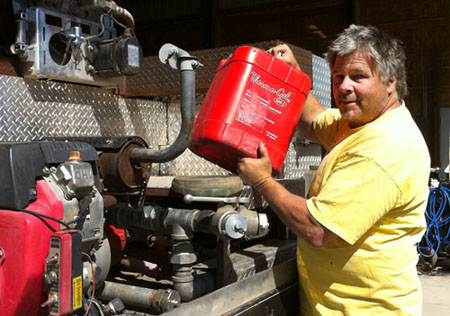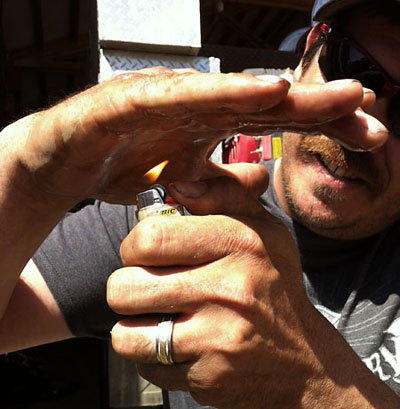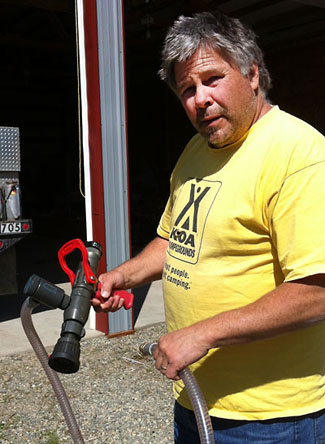home | internet service | web design | business directory | bulletin board | advertise | events calendar | contact | weather | cams

 Mike Meyers hefts a container of Thermo-Gel—a liquefied polymer—near a C2C Wildfire engine. Mike Meyers hefts a container of Thermo-Gel—a liquefied polymer—near a C2C Wildfire engine.Flame Off Mike Meyers and Mary Sukovaty, who have been running a successful contract fire-fighting business out of the Methow since 2003, have a new extra weapon for fighting fires: liquefied polymer gel. Their business, C2C Wildfire, can spray liquefied polymer onto a structure before the flames arrive. The brand they use is Thermo-Gel. It will protect a structure for about eight hours, Meyers explained, before a crew needs to rehydrate it by spraying water, which will “make it good for another eight.” The sprayed-on gel’s effectiveness in protecting the structure from flame begins to drop off after that, he said. “We’ve been doing it for five years,” Meyers said, “from Galveston, Texas to Winthrop and everywhere in between.” C2C Wildfire is one of four prime contractors in the country which store Thermo-Gel brand and contract to apply it. Other firms are in Texas, California, and Montana. Being in the forefront of wildfire protection methods is not new to the Methow Valley, which is famed for pioneering smokejumping.  Charles Hammer holds the flame of a cigarette lighter under his gel-slicked hand, demonstrating the gel’s protection against extreme heat. Charles Hammer holds the flame of a cigarette lighter under his gel-slicked hand, demonstrating the gel’s protection against extreme heat.While the liquefied polymer is tough against heat, it can’t take freezing, so Meyer’s storage shed is heated through the winter. And the gel, stored in five containers, needs “a fairly intense shaking twice per year,” Meyers said. “We gelled 11 historic mining structures in the town of Liberty near Ellensburg” last summer, said Meyers, to protect them against the Table Mountain Fire. “We were successful with all but one.” The gel-spraying firefighters couldn’t safely get back to that one structure to re-spray it with water before the fire swept through. Meyers said that was the first time an engine had been used to pre-gel historic structures on a Forest Service fire. Firefighters can spray the gel from backpacks, but “it’s heavy and it’s slimy,” Meyers said. It can also be sprayed from fire engines. A C2C Wildfires employee, Charles Hammer, interrupted his work at C2C’s home base between Twisp and Winthrop long enough to demonstrate the properties of the gel: he held a cigarette lighter’s flame against the palm of his gel-covered hand for about 20 seconds before he felt the heat. “The water-absorbent polymers in fire-retardant gels are similar to those used in diapers,” according to Wikipedia. “The polymer … soaks up hundreds of times (its) weight in water creating millions of tiny drops of water surrounded by and protected by a polymer shell. The result is a "bubblet" or a drop of water surrounded by a polymer shell in contrast to a bubble which is air surrounded by liquid.  Mike Meyers explains the inner workings of the highly engineered nozzle that mixes about 1.5% Thermo-Gel to 98.5% water as firefighters coat a structure to protect it. Mike Meyers explains the inner workings of the highly engineered nozzle that mixes about 1.5% Thermo-Gel to 98.5% water as firefighters coat a structure to protect it.As the gel and water are sprayed onto an exposed surface, millions of tiny "bubblets" are stacked one on top of another. The stacking of the water "bubblets" forms a thermal protective ‘blanket’ over the surface to which it is applied. In order for the heat of the fire to penetrate the protected surface, it must burn off each layer of the gel "bubblets" coating. Each layer holds the heat away from the next layer of bubblets beneath.” The gel will work up to 1,300 degrees Fahrenheit, Meyers said. Meyers also contracts for more traditional firefighting—hand crews with hand tools. He has plenty of fire-fighting background. He first worked fire on the Winthrop Ranger District’s crew in 1975, eventually graduating to the La Grande, Oregon hotshot crew before he returned home to the Methow to help out at the KOA Campground near Winthrop when his father’s health began to fail in 1983. He still works at the family’s campground, but fire is in his blood, which is why he started to fight fire again, this time as a contractor. He and his wife, Mary Sukovaty, decided to start C2C Wildfire and have been building the business since then. When Meyers needs experienced crews members for a blaze somewhere, he can hire locals already experienced as firefighters, hotshots and smokejumpers. He says he has “twenty plus” people to tap “on the fire side. Good crew.” C2C Wildfire also assesses fire danger near homes and advises homeowners how to make their buildings more wildfire-resistant. 5/7/2013 Comments
|